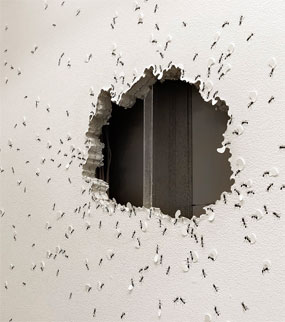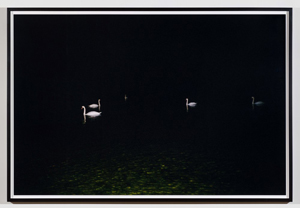Colonial Art
John Haberin New York City
Catherine Chalmers, Ryan Foerster, and Shuvinai Ashoona
Colonialism is destructive of people, their lands, and their voices. If art has learned anything from the drive for greater diversity, it is this. But what if today's wisdom is wrong? Maybe it depends on the colonizer.
One in particular brows blows a gaping hole in the Drawing Center, only not this time an invader from Europe. What may look at first like the dark remnants of an explosion is an ant colony, and the ants themselves are just pen and ink. If they carry bits of paper and drywall to every side, they are also a model for Catherine Chalmers. Unlike imperialism or many a career in art they thrive on cooperation. But then the shows back upstairs feature General Idea, an artist collective, and Ibrahim El-Salahi, who knows a lifetime of art movements and solitary pain—and if you think that is messy or bestial, just wait until you see Ryan Foerster. For that matter, if you are content to leave art to the beasts, perhaps a polar bear, picture the Arctic with Shuvinai Ashoona. 
Warrior ants
Catherine Chalmers has been learning from leafcutter ants for a decade now, on field trips to Costa Rica, where they proliferate but never run wild. She can only observe and encourage them. As a colorful scroll has it, Colonize the Earth, and they sure come close. Their tunnels can run to ten square yards and twenty feet deep. Other drawings create their own Drawing Center Colony. Entering the basement gallery is going deep.
Her works on paper have a meandering lightness, like the ants. Their branching tunnels cannot keep to straight lines, and they leave plenty of white space. Yet their parallel sides reinforce the motion within. Still other drawings add touches of watercolor for leaves. They also add an upbeat message, as We Rule (the same as the exhibition title), We Roar, and Queens of the World. There may be male ants, but Chalmers is cheering herself on as well.
Text like this speaks to a new wave of feminism, with no room for irony or suffering. Foul workplace culture and #MeToo? Not for us, and not for ants. Still, she sees a broader parallel to human civilization, including language ritual, war, and art. Some ants, she says, are "minigladiators." Then, too, if you have trouble seeing any of this in her work, she cares most for cooperation.
She thinks of the ants not as subjects, but as collaborators—with each other and with her. "I always work," she says, "with an animal's natural behavior," with an imperative to watch, to respond, to experiment, and to adjust. On video, she collaborates too, supplying leaves for the ants to bear away. If paper leaves are short of nourishment, they are long in color and the insects are Builders of Greatness all the same. The hole in the wall exposes a metal stud, and one can imagine them cleaning up after the damage. They have already done their work to renew her.
The Drawing Center reserves its basement for younger artists and experiments, if not always in art and science. Its main gallery gets serious in everything but art. General Idea had been making conceptual art since moving from Toronto to New York at the start of the AIDS crisis, and its drawings are never far from death. Jorge Zontal, who executed them on behalf of AA Bronson and Jorge Zontal, died in their production in 1993. He started seeing floaters, taking the form of cockroaches that appear in his watercolor and gouache along with floating lips, wiggly amoebas, high-heeled birds, and whatever else crosses his mind. This is terminal illness as terminal whimsy.
Ibrahim El-Salahi calls his current project "Pain Relief Drawings," and he has known his share of pleasure and pain. Now past ninety, he still has a wiry line and unsettled intricacy. Abstract, confessional, or totemic, the series also incorporates patches of color from postage stamps and the labels on his medicine. Its well over one hundred small drawings bridge Surrealism, Pop Art, and Arab calligraphy. They may bear memories of London and Sudan, but private ones. Were they not so private, the medicine packets or a many-armed monster would not be half so personal.
Fiction and friction
Ryan Foerster keeps starting over, and viewers had better do so, too. His work is undeniably real, at once visible and tactile, until one tries to pin it down. Photograms may have a slippery layer of white, whether brushed, smeared, or stained. One could almost forget how little it covers. It makes the flatter background in electric red or blue that much more elusive and that much more in your face. Each time, I kept thinking, I shall finally remember it all and know what it means.
 Good luck with that. I may have needed to reassure myself that what I thought I had seen was still there. The gallery itself is on the edge of Chinatown, between the Lower East Side and Tribeca, as if uncertain where it, too, belongs. No wonder Foerster keeps slipping away. Not that the busy show lacks for incursions into the third dimension. They make it that much harder to avoid and harder to describe.
Good luck with that. I may have needed to reassure myself that what I thought I had seen was still there. The gallery itself is on the edge of Chinatown, between the Lower East Side and Tribeca, as if uncertain where it, too, belongs. No wonder Foerster keeps slipping away. Not that the busy show lacks for incursions into the third dimension. They make it that much harder to avoid and harder to describe.
A ceramic bowl rests on three mismatched legs, as if it were about to crash to the floor. Its decorative surface could belong to porcelain from almost anywhere, from past civilizations to the bargain bin. Measuring tape doubles back on itself just overhead, more than once at that. Foerster adopts metal slide-action measuring tape not a tailor's softer kind, and its sharp edge and jumbled shape make it an unsettling intrusion. It might come from the gallery's architect or his own studio, as if to take their measure. Suffice it to say that it is already rusting and never will.
A jumble of other sculpture rests on a table, as ragtag as in all too many a show of ceramics these days. Still more sharp-edged metal rests on the floor like a flower bed or an uncomfortable footrest. Foerster has cut out the shapes of animals in motion and filled the gap with soil. It looks none too fertile, and the animals might have already taken off. Not that one can firmly identify the species. Another aluminum sculpture has that much sharper edges and greater lack of symmetry, for all its stability, although benches out on the sidewalk offer more lasting relief.
His heart, though, still lies in photography and photograms. The first allows overprinting, and Foerster claims a debt to the time-lapse image of Eadweard Muybridge in the nineteenth century, with their own illusion of motion. Photograms, in turn are at once ghostly and a record of the thing itself in touch with photo-sensitive paper, from Man Ray and the Bauhaus to today. One work is Back to Black and another Looking Negative. The show's title, "Frictional Archaeology," combines friction's surface rubbing and stumbling block with archaeology's physical relics of what is no longer alive. If you misread it as "fictional," so did I.
The prints include recognizable images, like a monkey labeled his self-portrait, but their ghastly beauty adds a bit of slippage itself. Swans rest on a pond at night, as sheer white on black waters, and a roller coaster could promise a harsh ride if only it were abandoned. Mother's Puppet could be a shadow of his mother or her puppet show, as if Sophie Taeuber-Arp put on a show just for him. It looks half funny, half scary all the same. Is an artist so hard to follow just lacking direction? If so now I am, too.
A bear of a work
If you live in the Arctic cold, you had better cherish your way of life. For an artist, but not only for an artist, that includes the traditions that shape one's craft. Still, you might welcome a little company now and then beyond "the people"—in the native language, the Inuit. It might even open the imagination to a certain challenge. Shuvinai Ashoona finds that challenge, too, in an unlikely place. She draws Polar Bear Sketching People.
At over eight feet long, a work by that name also has ample room for a rabbit making art and a still more fantastic being, plus a more ordinary circle of women friends in a reassuringly domestic interior. Another row of women is slightly less artistic but just as proud, as Holding What They Made in Town. And what they made is clothing, which it may require leaving home now and then to communal facilities with shared tools and access to markets. Made My Clothing at Clothing Center says so, although there two women are joined by that might be their pets carrying on their craft as well. Closer to home, a husband and wife can still appear carving soapstone together. Either way, they proclaim, Keep the Circle Stronger.
Way too glib and reassuring? Much of today's celebration of diversity in art can seem that way, but reassurance may not come quite as easily as first appears. An Inuk, or Inuit person, Ashoona lives on Baffin Island in the territory of Nunavut and the Northwest Passage, between Greenland to the north and the Hudson Bay. Yet the warmth of a parka appears just twice, unless you count the fur of a polar bear, and what the women made in town are t-shirts. I am shivering already. New York winters are bad enough.
Ashoona is nurturing fantasy while attesting to a way of life. One scene takes place under the sea. She is also broadening her vista to take into account the breadth in her mind of that way of life. In another work, she is Drawing Like an Elephant, a creature that does not often keep company with Eskimo and Inuit, even if it could draw. Her technique, too, looks to traditional Asian art and its calligraphic impulse. Her primary media are colored pencil and ink on paper.
This gallery has a fondness for the influence of folk art, in cultures far from New York and most often to the South, as with Dawn Williams Boyd, Myrlande Constant, and Willie Birch. This is Ashoona's first exhibition here. Still, this is work on paper on an ambitious scale, although not uniformly so. It is also sophisticated enough to accommodate her chosen media's gentle colors and dappled light, with dense spots of gouache akin almost to Pointillism. Colored pencil lends a wavering texture. Ink enters to thicken outlines and to flatten form.
She also nurtures paradox, between work on paper and mural scale—or between fantasy and that way of life. It allows rocks and sea to take on a shaping role, close to abstraction, while the figures remain less than grounded. One image, again at eight feet long, shows people in boots, Moving Our Campsite. Another, at eight feet high, assigns separate groups of people to sky and sea. You can always blame climate change for the absence of ice. Then, too, you need not see the ice to relish the warmth or to know that the ice is there.

Catherine Chalmers, General Idea, and Ibahim El-Salahi ran at the Drawing Center through January 13, 2023, Shuvinai Ashoona at Fort Gansevoort through November 4. Ryan Foerster ran at Martos through April 30, 2022, with additional older work at Shoot the Lobster through June 4.




